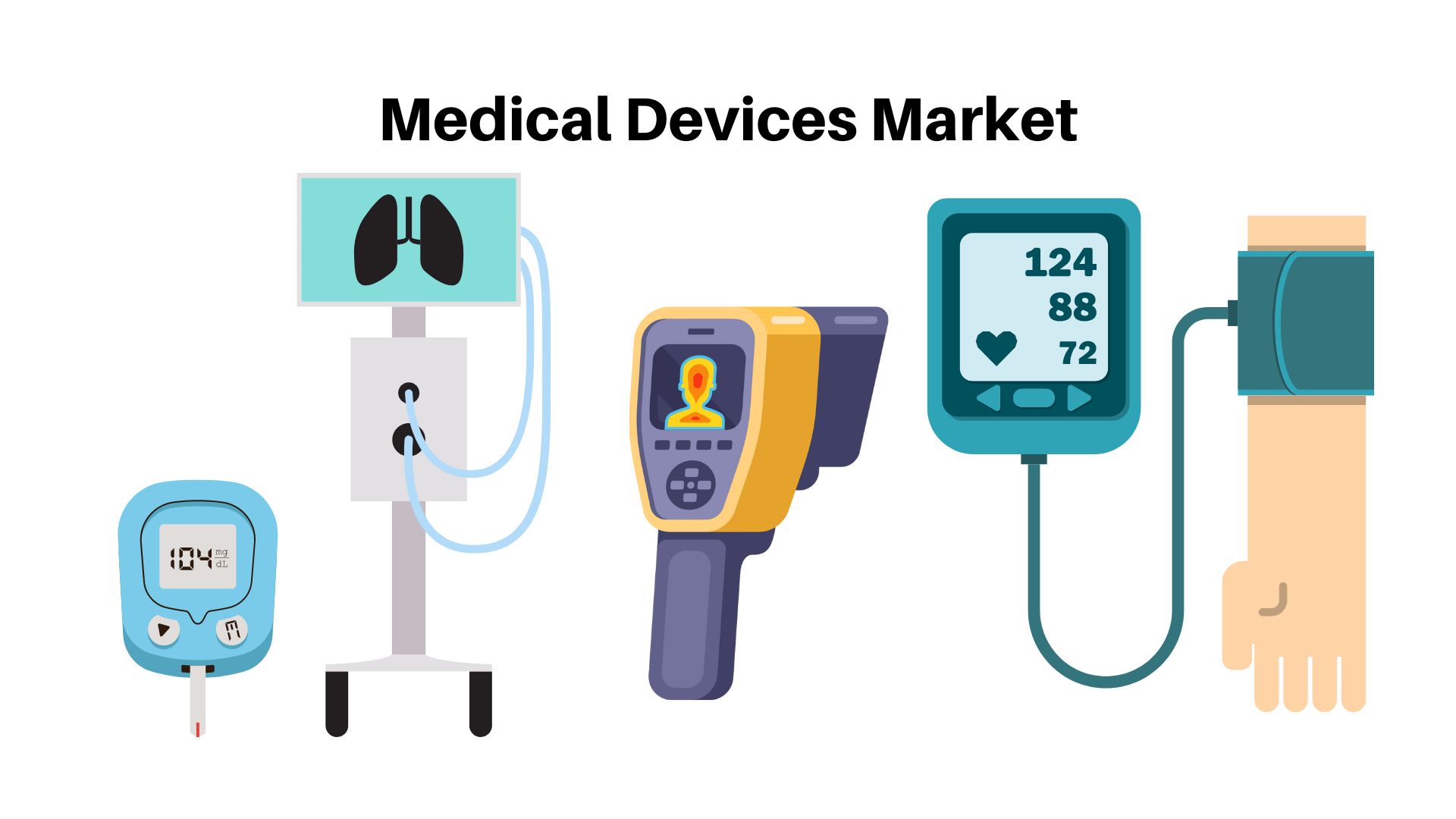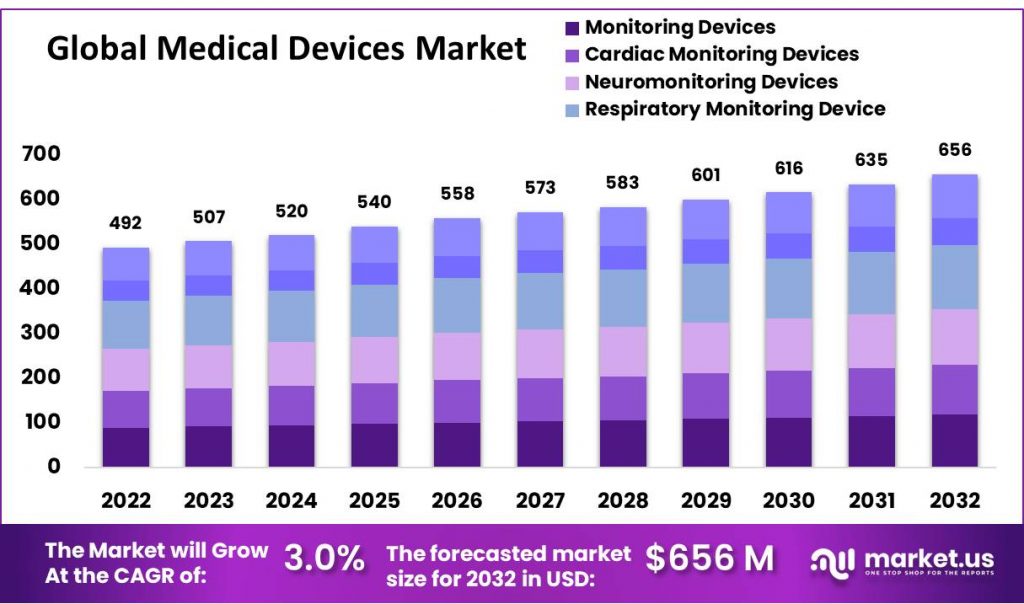Medical Devices Market Is Encouraged to Reach USD 656 Million by 2032

Page Contents
Medical Devices Market Overview
The medical devices market includes a broad range of products such as instruments, apparatuses, machines, implants and software that assist in diagnosing, treating and monitoring various medical conditions. Estimates place the global medical devices market size at USD 492 million in 2022 and it's expected to reach USD 656 million by 2032 with an annual compound growth rate (CAGR) of 3% from 2022-2032.
The medical devices market is being driven by several factors, including an increasing prevalence of chronic illnesses such as cardiovascular diseases, diabetes, and cancer; an aging population; technological advances; and demand for minimally invasive surgical procedures.
The medical devices market is fiercely competitive, boasting a multitude of players from large multinational corporations to small and medium-sized enterprises. Key players in the sector include Medtronic plc, Johnson & Johnson, Abbott Laboratories, Siemens Healthineers AG and General Electric Company.
Download an exclusive sample of Medical Devices Market Report: https://market.us/report/medical-devices-market/request-sample/

Key Takeaways
- The global medical devices market size was estimated at USD 492 million in 2022 and is projected to reach USD 656 million by 2032, with a CAGR of 3% from 2022 to 2032.
- The medical devices market is being driven by several factors, including an increased prevalence of chronic diseases like cardiovascular diseases, diabetes, and cancer; an aging population; technological advances; and an increasing need for minimally invasive surgical procedures.
- North America is the leader in medical devices, followed closely by Europe and Asia Pacific.
Regional Snapshot
- North America currently dominates the market and is projected to maintain its growth trajectory during the Forecast Period.
- North America is expected to remain the market leader for medical devices over the forecast period, due to factors such as an increasing burden of chronic disease, high healthcare spending and presence of key players.
- The market growth is forecasted to be supported by Canada's growing geriatric population over the forecast period. According to United Nations Population Fund's 2022 statistics, Canada boasts a large population between 15-64 years old – accounting for 65% of its overall population.
- According to Statistics Canada, ~19% of Canadians will be 65 or older by 2022. With an aging population, individuals are increasingly at risk for chronic illnesses like respiratory diseases, cardiopulmonary diseases and orthopedic disorders. This will drive demand for medical imaging and surgical procedures over the forecast period.
- Europe: Europe is the second-largest market for medical devices, accounting for 30% of global sales. This region stands out due to its advanced technological infrastructure and well-developed healthcare system – particularly in Germany, France, and the United Kingdom.
- Asia Pacific: The Asia Pacific region is expected to experience rapid growth over the coming years due to factors such as rising healthcare expenditure and greater awareness about HIV/AIDS prevention initiatives. Healthcare services and increased demand for medical devices in emerging economies like China and India are driving this regional market; Japan is by far its biggest player, followed by China and India.
- Latin America: The medical device market in Latin America is relatively small but growing, driven by factors such as rising healthcare expenditure and increased awareness about treatments available. Due to these dynamics, Brazil has emerged as the leading supplier of these devices in the region followed by Mexico and Argentina.
- Middle East and Africa: Although the Middle East and Africa are relatively small markets for medical devices, they are expected to experience significant growth over the coming years due to factors such as rising healthcare expenditure and an increasing need. Saudi Arabia and South Africa are currently two of the major players within this space.
Purchase This Report Via This Secured Link And Avail Discount: Get this Report
Drivers
- Increased Prevalence of Chronic Diseases: The rising incidence of chronic diseases such as cardiovascular diseases, diabetes, and cancer is driving the demand for medical devices. Medical devices help diagnose, treat, and manage these illnesses.
- Aging Population: As the global population ages, the demand for medical devices is expected to increase. Elderly individuals are particularly vulnerable to chronic illnesses and require additional healthcare support. Technological Advancements: Rapid advances in technology are fueling innovation within the medical devices sector. This includes creating new devices and software to enhance patient care.
- Minimally Invasive Procedures: As patients seek less invasive surgical options that can speed recovery time and enhance outcomes, the demand for minimally invasive techniques is growing. This has driven the development of new medical devices that make these procedures possible.
- Favorable reimbursement policies: Favorable reimbursement policies are fueling the demand for medical devices by alleviating financial strain on both patients and healthcare providers. Governments and private insurance companies are increasingly providing reimbursement for medical devices, encouraging the adoption of advanced technologies.
Restraints
- Stringent Regulatory Requirements: The medical devices market is heavily regulated, and companies must meet stringent guidelines in order to bring new products onto the market. This may lead to a long and expensive approval process which may serve as an impediment for smaller startups.
- High Cost of Medical Devices: Medical devices can be expensive, and some patients may not be able to afford them. This may limit demand for these items, particularly in low- and middle-income countries. Middle-income countries face limited reimbursement options: While favorable reimbursement policies can spur demand for medical devices, limited funding sources can pose a barrier to adoption. In some cases, medical devices may even need to be donated in order to obtain approval.
- Lack of Skilled Healthcare Professionals: Medical devices require experienced healthcare personnel to operate them correctly. In certain regions, there may be an acute shortage of these professionals, which could hinder the adoption of medical devices.
- Economic Uncertainty: Economic uncertainty can have an adverse effect on the medical devices market as healthcare providers may postpone investments in new technologies during times of economic strain. Additionally, patients may put off or forgo medical treatment during times of economic difficulty, potentially impacting the demand for medical devices.
Opportunities
- Emerging Markets: Emerging markets such as China, India, and Brazil provide significant growth prospects for medical device manufacturers. These nations boast a large population base, expanding middle class, and increasing demand for healthcare services.
- Personalized Medicine: Personalized medicine is an emerging field that utilizes genetic information to customize medical treatments according to a patient's individual needs. This approach is expected to spur the development of new medical devices and technologies.
- Telemedicine: Telemedicine is an emerging field that allows patients to receive medical care remotely. The COVID-19 pandemic has expedited this adoption of telemedicine, leading to unprecedented levels of remote patient monitoring and care. This trend is expected to persist, providing medical device manufacturers with an opportunity to develop innovative technologies that facilitate telemedicine.
- Internet of Things (IoT): The Internet of Things is an evolving technology that connects devices to the internet and enables them to communicate with each other. This trend has shown remarkable success over its early years, proving its worth as a source of innovation and productivity across industries. Medical devices have the potential to revolutionize the market by enabling devices to collect and share data in real time, leading to improved patient outcomes and reduced healthcare costs.
- Artificial Intelligence (AI): Artificial intelligence (AI) is an emerging technology with the potential to revolutionize the medical devices market. AI can be employed in analyzing large amounts of medical data and recognizing patterns that can aid diagnosis and treatment decisions, ultimately improving patient outcomes while cutting healthcare costs.
Challenges
- Competition Increases: The medical devices market is highly competitive, necessitating companies to innovate continuously in order to stay ahead. This may result in higher research expenses and lower production rates. Profit margins could also be affected due to cybersecurity threats. With medical devices becoming more connected to the internet, they become vulnerable to cybersecurity attacks that could endanger patient safety or cause significant financial loss.
- Regulatory Challenges: Regulatory issues, such as evolving regulatory requirements and increased scrutiny from regulatory agencies, can negatively affect the growth of the medical devices market. Companies must ensure they adhere to applicable regulations in order to avoid fines or penalties.
- Intellectual Property Challenges: Intellectual property issues, such as patent disputes and infringement claims, can negatively impact the growth of the medical devices market. Companies must safeguard their intellectual property to retain a competitive edge.
- Ethical Considerations: The creation and use of medical devices engender ethical dilemmas, such as the appropriate use of technology, patient privacy rights, and the impact on vulnerable populations. Companies must consider these ethical considerations to maintain public trust and prevent reputational damage.
Recent Developments
- Artificial intelligence (AI) and machine learning (ML) in medical devices: AI and ML are increasingly being integrated into medical devices to enhance diagnosis and treatment. For instance, this could include implanting artificial intelligence into a pacemaker to enable faster diagnosis. AI algorithms can analyze medical images with greater precision than human doctors are able to detect tumors or other anomalies.
- 3D Printing: 3D printing is an increasingly popular technology being employed in the production of medical devices. This process enables manufacturers to craft complex and personalized devices tailored specifically for individual patients.
- Wearable Medical Devices: Wearable medical devices, such as smartwatches and fitness trackers, are becoming more widely used. These can monitor vital signs and provide real-time feedback to patients and healthcare providers.
- Remote Patient Monitoring: Remote patient monitoring allows healthcare providers to keep an eye on patients' health remotely, using medical devices like blood glucose meters or blood pressure machines. Monitors are especially beneficial for patients with chronic illnesses who need regular monitoring.
- Robotics in Surgery: Robotic surgery is becoming more and more prevalent, providing surgeons with greater precision and less invasive options. For instance, robotic surgery can be employed to perform complex procedures like prostatectomies with greater accuracy while causing patients less pain.
- Medical Device Cybersecurity: Medical device cybersecurity has become an increasingly critical concern, due to the growing use of connected medical devices. Manufacturers are investing in cybersecurity measures to guard against cyber attacks and guarantee patient safety.
Key Market Segments
Based on Product
- Monitoring Devices
- Cardiac Monitoring Devices
- Neuromonitoring Devices
- Respiratory Monitoring Device
- Multi-Parameter Monitoring Devices
- Hemodynamic Monitoring Devices
- Fetal and Neonatal Monitoring Devices
- Temperature Monitoring Devices
- Weight Monitoring Devices
- Diagnostic Devices
- Surgical ENT Devices.
- Endoscopes
- Imaging Devices
- Diagnostic Molecular Devices
- Drug Delivery Devices
- Surgical Devices
- Bio Implants and Stimulation Devices
- Treatment Equipment
- Infusion Pumps
- Medical lasers and LASIK surgical machines
Based on End-User
- Hospitals & Clinics
- Diagnostic Centers
- Research laboratory
- Pharmaceutical companies (Shopping Plazas, Military, Corporate Sectors, Hostels)
Key Market Players
- Medtronic Plc
- Abbott Laboratories Inc
- Johnson & Johnson
- Siemens Healthineers AG
- Becton, Dickinson, and Company
- Accord Medical Products Private Limited
- 3M Company
- ARKRAY Healthcare Pvt. Ltd
- Baxter International Inc.
- Agappe Diagnostics Ltd
- Braun Medical Inc.
- BioTelemetry Inc.
- Canon Medical Systems Corporation
- Boston Scientific
- Chart Industries
- Danaher Corporation
- Dentsply Sirona
- Covidien Healthcare
- Fisher & Paykel Healthcare
- Hoffmann-La Roche Ltd
- Envista Holdings Corporation
- Fesenius Medical Care
- FUJIFILM Holdings Corporation
- General Electric Company
- Fresenius Medical Care
- Hitachi Group
- Masimo Corporation
- NIPRO Corporation
- ResMed Inc.
- SIEMENS AG
- SCHILLER Healthcare
- Shanghai Runda Medical Technology Co. Ltd.
- Stanley Healthcare
- Getinge Group
- Hamilton Medical AG
- Koninklijke Philips N.V.
- Lepu Medical Technology Company Co. Ltd
- Metran Co. Ltd
- Nihon Kohden Corporation
- Novartis
- Teleflex Medical
- Themis Bioscience
- Olympus Corporation
- PHILIPS HEALTHCARE
- Roche
- Terumo Corporation
- Shandong WeiGao Group Medical Polymer Company Limited
- Shinva Medical Instrument Company Limited
- Smiths Medical
- Jude
- Stryker Corporation
- SunMed
- Yuwell – Jiangsu Yuyue Medical Equipment & Supply Co. LtdYuyue Medical Equipment & Supply Co. Ltd
Interested to Procure the Data? Inquire here at https://market.us/report/medical-devices-market/#inquiry
Nature Insights
Medical devices are an industry that is rapidly growing. This is due to technological advancements and increased demand for healthcare services. With an aging population and a rising need for healthcare services, there is a significant opportunity to grow the medical device market. As a result of chronic diseases, the demand for medical equipment is expected to increase in the next few years.
One trend that is driving the medical device market is personalized medicine. Personalized medicine means tailoring medical treatments to patients based on their individual needs genetic makeup and other variables. This approach is expected to drive the development of new medical devices, and technologies that can support personalized medicines.
Artificial intelligence (AI), machine learning (ML), and other technologies are also gaining popularity in the medical device market. These tools can be used to improve diagnosis, treatment, and management. AI and ML algorithms allow for the analysis of large amounts of medical data in order to identify patterns and provide insights that may be useful in medical decision-making.
Innovation in the medical device industry is also driven by the increasing use of connected medical devices. Connected medical devices, such as wearables and remote patient monitoring, can provide real-time data that can help improve patient outcomes.
Despite the immense potential and growth of the medical devices market, there are many challenges. These include rising competition, cybersecurity threats as well as regulatory challenges, intellectual property challenges, and ethical considerations.
Report Scope
| Report Attribute | Details |
| The market size value in 2022 | USD 492 Mn |
| Revenue forecast by 2032 | USD 656 Mn |
| Growth Rate | CAGR Of 3% |
| Regions Covered | North America, Europe, Asia Pacific, Latin America, and Middle East & Africa, and Rest of the World |
| Historical Years | 2017-2022 |
| Base Year | 2022 |
| Estimated Year | 2023 |
| Short-Term Projection Year | 2028 |
| Long-Term Projected Year | 2032 |
Contact us
Contact Person: Mr. Lawrence John
Market.us (Powered By Prudour Pvt. Ltd.)
Tel: +1 718 618 4351
Send Email: [email protected]
FAQ.
Medical devices refer to instruments, machines, implants, or other similar articles designed for use in diagnosing, treating, or preventing disease or other medical ailments.
The medical devices market refers to all articles used in diagnosis, treatment, or prevention that fall within this category - instruments, machines, implants, or other similar articles. This global sector includes instruments, machines, and implants as well as similar articles used for diagnosing, treating, or preventing diseases.
Factors such as an aging population, rising prevalence of chronic diseases, technological advancements and increasing demand for healthcare services are driving this market's expansion.
Obstacles facing this industry include increasing competition, cybersecurity threats, regulatory issues, intellectual property concerns and ethical considerations.
Recent advancements include the integration of artificial intelligence and machine learning into medical devices, as well as using 3D printing for manufacturing purposes.
Personalized medicine involves tailoring medical treatments to individual patients based on their genetic makeup and other factors. This approach is expected to propel growth in this sector of the industry. New medical devices and technologies that promote personalized medicine, such as genetic testing and targeted therapies, are being introduced.
The team behind market.us, marketresearch.biz, market.biz and more. Our purpose is to keep our customers ahead of the game with regard to the markets. They may fluctuate up or down, but we will help you to stay ahead of the curve in these market fluctuations. Our consistent growth and ability to deliver in-depth analyses and market insight has engaged genuine market players. They have faith in us to offer the data and information they require to make balanced and decisive marketing decisions.



